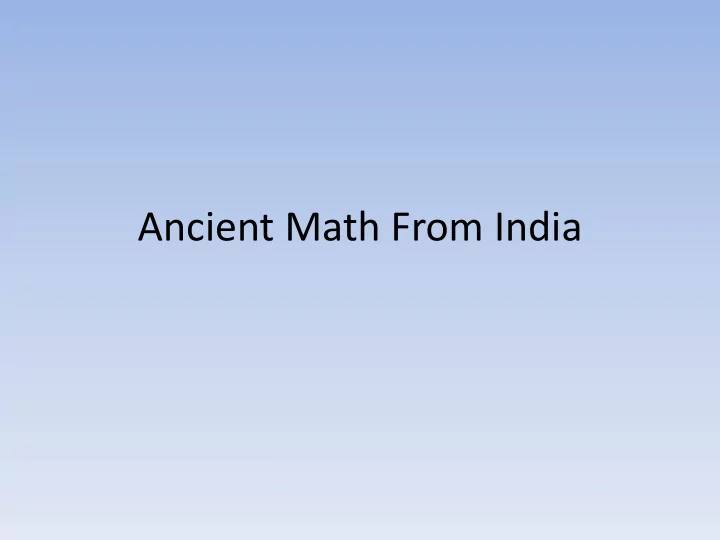

Ancient Math From India
The Vedic Age • Textbook : 1000BC 1500 – 500 BCE • Scriptures : >2500 BCE
Vedas • The Vedas (/ˈveɪdəz, ˈviː -/; Sanskrit: वेद véda, " knowledge ") are a large body of texts originating in ancient India. • Composed in Vedic Sanskrit, the texts constitute the oldest layer of Sanskrit literature and the oldest scriptures of Hinduis • Four Vedas: the Rig Veda, Sama Veda, Yajur Veda and Atharva Veda. • Transmitted orally from one generation to the next spanning more than 10,000 years. They came to us in written form between 4-6,000 years ago.
Rigveda • The Rig-Veda Samhita is the oldest significant extant Indian text. It is a collection of 1,028 Vedic Sanskrit hymns and 10,600 verses in all, organized into ten books • Adoration of dieties • Also dealt with other subjects, like the procedure of wedding, the folly of gambling. • About two-thirds of Rigveda is about the gods Agni (Fire) and Indra (Ruler of the demigods).
Yajurveda • consists of archaic prose mantras and also in part of verses borrowed from the Rig-Veda • Ritualistic and Sacrificial Worship
Samveda • The Sama-Veda is the 'Veda of chants' or 'Knowledge of melodies'. The name of this Veda is from the Sanskrit word saman which means a metrical hymn or song of praise . • Book of hymns
Atharvaveda • Atharvaveda means the Veda of the Wise and the Old . • It is associated with the name of the ancient poet Atharvan (The Wise Old One). It is also called Atharva-Angirasa, being associated with the name of another rishi, Angiras. • Herbs, Waters, Mind, Body, Diseases, etc and Mathematics!!
Vedic Mathematics • Vedic Mathematics is the name given to the ancient system of Mathematics which was rediscovered from the Vedas between 1911 and 1918 by Sri Bharati Krisna Tirthaji (1884- 1960). • gifted oratory in Sanskrit • Masters (MA) degree in six subjects – Sanskrit, English, History, Philosophy, Mathematics and Science - American College of Sciences in Rochester, New York • spent his next eight years studying advanced Vedanta philosophy • Next few years spent in meditation
• arithmetic : algorithms for whole number multiplication and division, (flag or straight) division, fraction conversion to repeating decimal numbers, calculations with measures of mixed units, summation of a series, squares and square roots (duplex method), cubes and cube roots (with expressions for a digit schedule), and divisibility (by osculation). • Geometric applications are reviewed for linear equations, analytic conics, the equation for the asymptotes, and the equation to the conjugate-hyperbola. Five simple geometric proofs for the Pythagorean theorem are given. [ A 5-line proof of Apollonius' theorem is given. • Physics, Trigonometry and astronomy
Write the numbers. Observe the pattern
Muhammad ibn Musa al-Khwarizmi Formerly Latinized as Algoritmi ,was a Persian [3] mathematician, astronomer and geographer during the Abbasid Caliphate, a scholar in the House of Wisdom in Baghdad. In the 12th century, Latin translations of his work on the Indian numerals introduced the decimal positional number system to the Western world. Al- Khwārizmī's The Compendious Book on Calculation by Completion and Balancing presented the first systematic solution of linear and quadratic equations in Arabic. Stamp issued by In Renaissance Europe, he was considered the original inventor soviet union of algebra, although it is now known that his work is based on older Indian or Greek sources -Source Wikipedia
What range of numbers did they know? • The use of zero, infinity , imaginary numbers and negative numbers • Decimal place value System : Integers and fractions. -Chinese, Egyptian glyphs, Vedas . All older than 300BCE • Greeks and Romans are introduced to “ babylonian numbers” around 150BC .
~580 BC Gautama Buddha is asked to “ count ” to the highest and lowest number he knows Physicists calculate: say that a finger is 4 centimeters long. The Buddha's "first atoms" are, therefore, 4 centimeters divided by 7 ten times, which is 0.04 meter x 7 to the minus 10 or 0.00000000001416 meter
Useful Links • http://www.hinduism.co.za/vedic.htm • Gresham College – https://www.youtube.com/watch?v=wUP5rtw vsUI • Value of Pi 3 rd century https://www.youtube.com/watch?v=TiKoB8nli d • https://www.youtube.com/watch?v=hEca1Mi E4GA
Recommend
More recommend